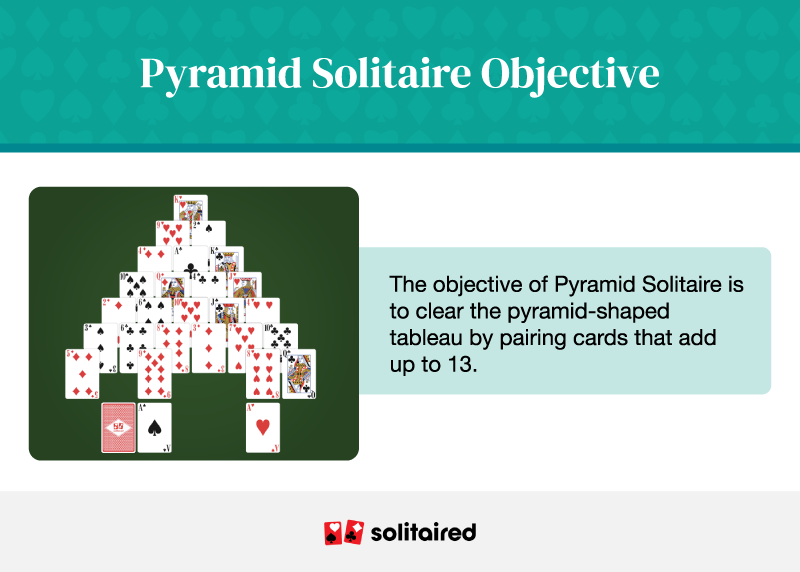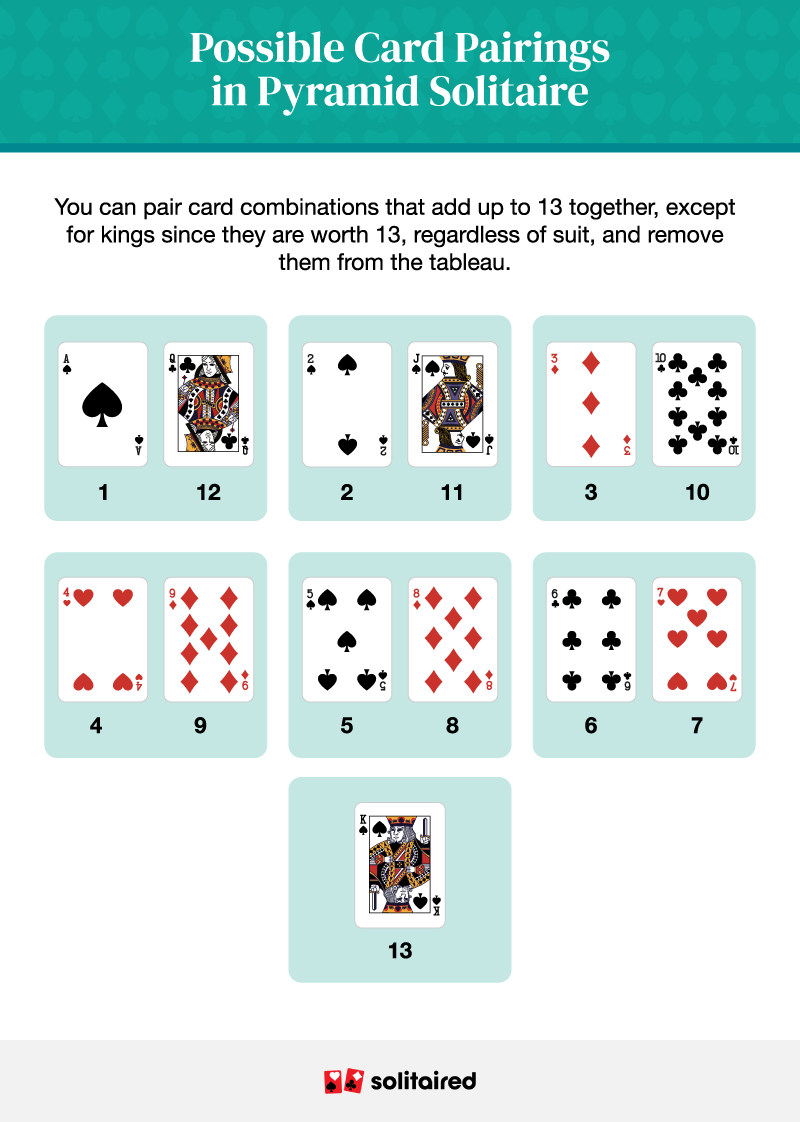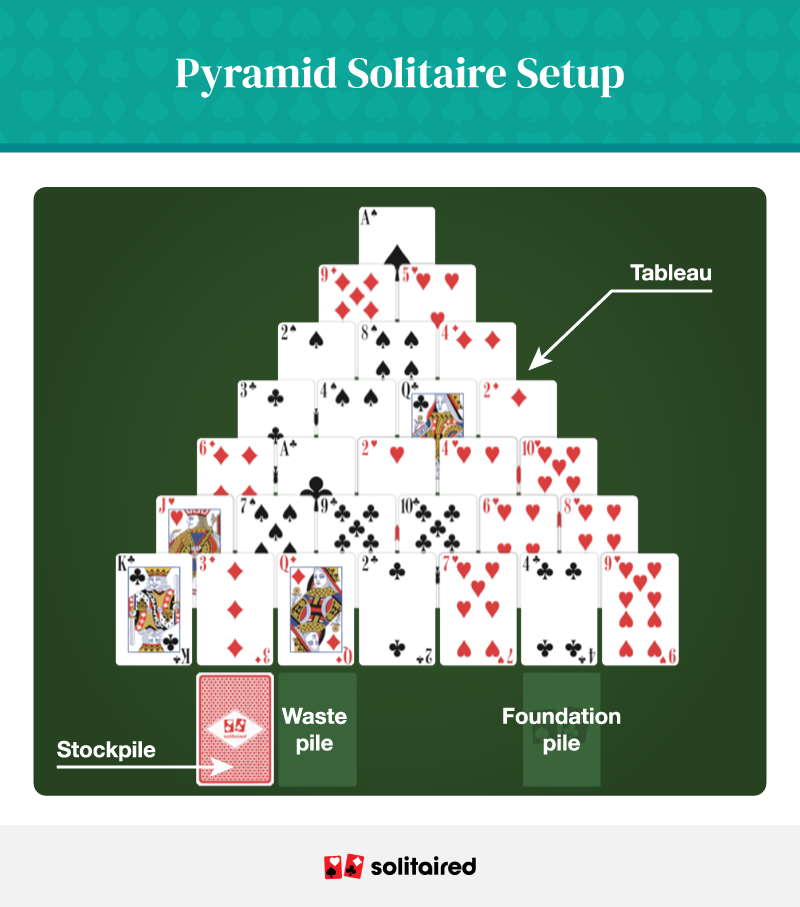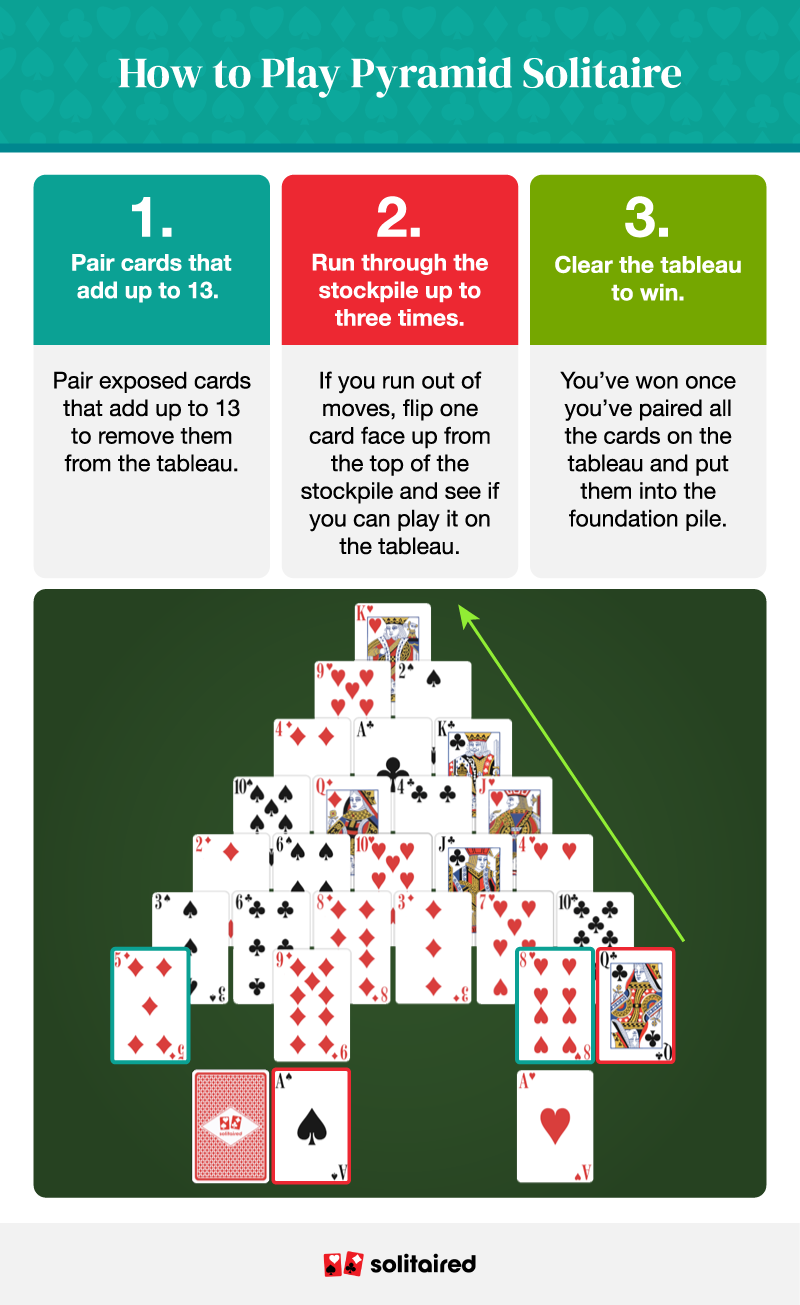How to Play Pyramid Solitaire (Rules & Strategies)
By Neal Taparia - 05/15/2024
Pyramid Solitaire is one of the easier Solitaire games. Although it’s a single-player game just like Klondike Solitaire, the actual gameplay differs. Using one deck of cards, you form a pyramid-shaped tableau. Instead of sequencing like in classic Solitaire, you play it by pairing cards that add up to 13. You can play Pyramid Solitaire and other variations of Solitaire on Solitaired.com.
In this post, we explain how to play Pyramid Solitaire, as well as how strategize for optimal gameplay.
The Objective
When playing Pyramid Solitaire, you need to clear the tableau by pairing exposed cards that add up to 13.

Here are the card values:
- Kings = 13 points and is the only single card that can be removed on its own
- Queens = 12 points
- Jacks = 11 points
- Aces = 1 point
- The remaining numbered cards are worth their face value
Here are the different ways you can pair cards:
- Ace (1) + queen (12)
- Two + jack (11)
- Three + ten
- Four + nine
- Five + eight
- Six + seven
- King (13)

Pyramid Solitaire Setup
There are four different areas in the Pyramid Solitaire setup — the tableau, stockpile, foundation pile, and waste pile.

- Tableau: Use a standard 52-card deck and arrange 28 face-up cards in a pyramid shape. You can build this by starting with one card in the top row, two in the row below that, and so on until you put down seven cards in the bottom row.
- Foundation pile: This is where you place cards that you’ve paired, which you won’t use again.
- Stockpile: Also called the draw pile, you’ll put the last 24 facedown cards from the deck here. You can use these playing cards to make moves that advance cards from the tableau to the foundation pile. You can run through the stockpile three times.
- Waste pile: This is the discard pile, or where you’ll put the cards that are flipped up from the stockpile. The top card is the only card that can be used to pair with others on the tableau.
How to Play Pyramid Solitaire
Here are the different game rules for Pyramid Solitaire. Remember, you lose if you can’t match and remove all the cards in the tableau.

1. Pair Cards That Add Up to 13
Look at the cards on the tableau and see if you can match any exposed cards, which means cards that aren’t overlapped from the row below. You can only pair cards from the seventh row until additional cards are uncovered. Once you find a pair that adds up to 13, you place it in the foundation pile. Once you’ve put the cards in the foundation pile, they can’t be used again.
2. Use the Stockpile to Continue Play
If you can’t make any more moves on the tableau, you can flip a card up from the stockpile to the waste pile to see if it can be paired with a card on the tableau. You can go through the stockpile cards a maximum of three times. If you cycle through the stockpile for a third time and still have cards left on the tableau, you lose the game.
3. Clear the Tableau to Win the Game
The goal is to match all the pairs on the tableau. As soon as you pair all the cards in the tableau, you win the game!
Pyramid Solitaire Strategies to Win
Here are some helpful strategies in case you’re stuck while playing Pyramid Solitaire.
- Clear as much of a single row as possible at a time. If you go row by row, you can make sure you won’t block cards. This way, you can use them in future moves.
- Play kings immediately. Kings are worth 13, so play them as soon as you can. This will help free up space on the tableau so you can unblock the new cards you need.
- Prioritize cards in the tableau. Your first goal should be to remove cards from the tableau instead of using stockpile cards. That way, you remove more cards from the tableau and save stockpile cards for future moves that get you closer to winning.
- Assess the tableau constantly. Always watch the tableau and try to think ahead with your moves. This way, you’ll avoid blocking a card or using one from the stockpile that you might need later.
- Count the cards and remember the cards in the stockpile. There’s always going to be four of each card, so counting cards is your best shot at calculating moves. Keep counting as you move through the tableau and the stockpile and see if you have cards that you can pair.
- Use the stockpile as a last resort. Only use the stockpile as your last resort. You’re only allowed to cycle through it three times, so make sure you use it sparingly and concentrate on the tableau first.
- Use the undo button wisely. This is a huge help! You can use it to backtrack if you make a mistake, or you can use it to test different paths.
Other Pyramid Solitaire Variations
Once you’ve learned how to play Pyramid Solitaire, you can go on to try different variations of it. Some let you reshuffle the stockpile, while others have a time limit or scoring system based on how fast you move.
- Anubis Solitaire: Like Pyramid Solitaire, the goal of the game is to remove pairs that add up to 13. You get three waste piles and use 45 cards to make the pyramid, which means you need two decks of cards to play. This makes the game slightly easier since you have more stockpile cards from which to make pairs, but the extra deck gives you more to keep track of.
- Apophis Solitaire: This version is very similar to Pyramid Solitaire, except you get to use three waste piles instead of one. This makes the game much easier, as you have more chances to pair up cards with the stockpile.
- Cheops Solitaire: Instead of having cards that add up to 13, you remove pairs of cards with consecutive ranks and only get one pass through the stockpile, which increases the difficulty of the game.
- Double Pyramid Solitaire: With this version, the same rules apply except two decks of cards are used, which increases the challenge.
- King Tut Solitaire: Set up like Pyramid Solitaire, the challenge is greater because you have to deal three cards at once into the stockpile, but only the top card can be used. However, you can have unlimited use of the stockpile.
- Pyramid Dozen Solitaire: This is played just like Pyramid Solitaire, except you make pairs that add up to 12, not 13.
Start Playing Pyramid Solitaire Now!
The more you practice, the better you’ll get at winning Pyramid Solitaire! Solitaired has lots of online card games, including Pyramid Solitaire, that you can start playing immediately without downloading an app or registering your email.
You can log in if you want to save your scores and compete with friends, as well as get tutorials for playing games. If you want to check out the challenge of Pyramid Solitaire, check out Solitaired today.
About the author

